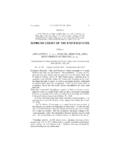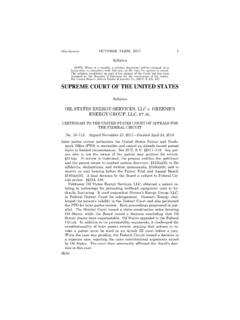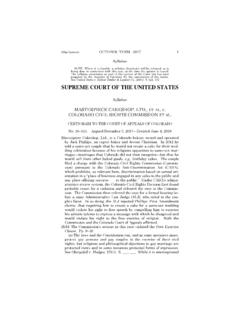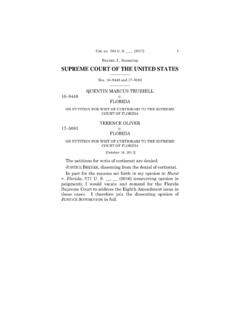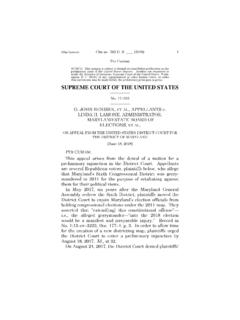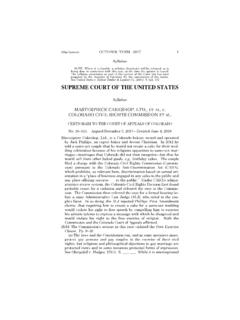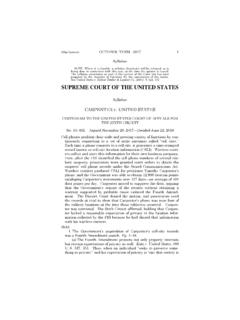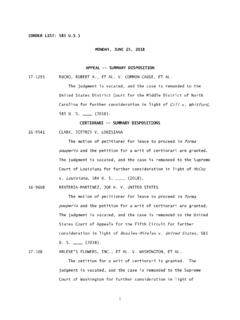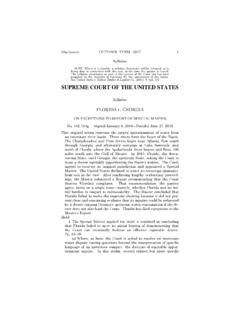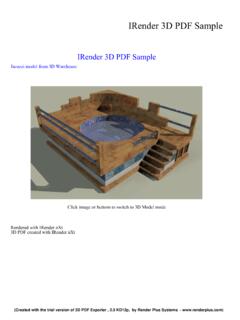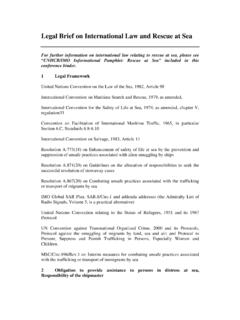Transcription of SUPREME COURT OF THE UNITED STATES
1 1 (Slip Opinion) OCTOBER TERM, 2014 Syllabus NOTE: Where it is feasible, a syllabus (headnote) will be released, as isbeing done in connection with this case, at the time the opinion is syllabus constitutes no part of the opinion of the COURT but has beenprepared by the Reporter of Decisions for the convenience of the reader. See UNITED STATES v. Detroit Timber & Lumber Co., 200 U. S. 321, 337. SUPREME COURT OF THE UNITED STATES Syllabus GLOSSIP ET AL.
2 V. GROSS ET AL. CERTIORARI TO THE UNITED STATES COURT OF APPEALS FOR THE TENTH CIRCUIT No. 14 7955. Argued April 29, 2015 Decided June 29, 2015 Because capital punishment is constitutional, there must be a constitu-tional means of carrying it out. After Oklahoma adopted lethal injec-tion as its method of execution, it settled on a three-drug protocol of (1) sodium thiopental (a barbiturate) to induce a state of uncon-sciousness, (2) a paralytic agent to inhibit all muscular-skeletalmovements, and (3) potassium chloride to induce cardiac arrest.
3 In Baze v. Rees, 553 U. S. 35, the COURT held that this protocol does not violate the Eighth Amendment s prohibition against cruel and unu-sual punishments. Anti-death-penalty advocates then pressured pharmaceutical companies to prevent sodium thiopental (and, later,another barbiturate called pentobarbital) from being used in execu-tions. Unable to obtain either sodium thiopental or pentobarbital,Oklahoma decided to use a 500-milligram dose of midazolam, a seda-tive, as the first drug in its three-drug protocol.
4 Oklahoma death-row inmates filed a 42 U. S. C. 1983 actionclaiming that the use of midazolam violates the Eighth of those inmates filed a motion for a preliminary injunction and argued that a 500-milligram dose of midazolam will not render themunable to feel pain associated with administration of the second and third drugs. After a three-day evidentiary hearing, the District Courtdenied the motion. It held that the prisoners failed to identify a known and available alternative method of execution that presented a substantially less severe risk of pain.
5 It also held that the prison-ers failed to establish a likelihood of showing that the use of midazo-lam created a demonstrated risk of severe pain. The Tenth Circuit affirmed. Held: Petitioners have failed to establish a likelihood of success on the merits of their claim that the use of midazolam violates the Eighth 2 GLOSSIP v. GROSS Syllabus Amendment. Pp.
6 11 29. (a) To obtain a preliminary injunction, petitioners must establish,among other things, a likelihood of success on the merits of theirclaim. See Winter v. Natural Resources Defense Council, Inc., 555 U. S. 7, 20. To succeed on an Eighth Amendment method-of-execution claim, a prisoner must establish that the method creates ademonstrated risk of severe pain and that the risk is substantialwhen compared to the known and available alternatives. Baze, su-pra, at 61 (plurality opinion).
7 Pp. 11 13.(b) Petitioners failed to establish that any risk of harm was sub-stantial when compared to a known and available alternative methodof execution. Petitioners have suggested that Oklahoma could exe-cute them using sodium thiopental or pentobarbital, but the DistrictCourt did not commit a clear error when it found that those drugs are unavailable to the State. Petitioners argue that the Eighth Amend-ment does not require them to identify such an alternative, but theirargument is inconsistent with the controlling opinion in Baze, which imposed a requirement that the COURT now follows.
8 Petitioners also argue that the requirement to identify an alternative is inconsistentwith the COURT s pre-Baze decision in Hill v. McDonough, 547 U. S. 573, but they misread that decision. Hill concerned a question of civ-il procedure, not a substantive Eighth Amendment question. That case held that 1983 alone does not require an inmate asserting amethod-of-execution claim to plead an acceptable alternative. Baze, on the other hand, made clear that the Eighth Amendment requires a prisoner to plead and prove a known and available alternative.
9 Pp. 13 16. (c) The District COURT did not commit clear error when it found thatmidazolam is likely to render a person unable to feel pain associatedwith administration of the paralytic agent and potassium chloride. Pp. 16 29. (1) Several initial considerations bear emphasis. First, the Dis-trict COURT s factual findings are reviewed under the deferential clear error standard. Second, petitioners have the burden of per-suasion on the question whether midazolam is effective. Third, the fact that numerous courts have concluded that midazolam is likely torender an inmate insensate to pain during execution heightens the deference owed to the District COURT s findings.
10 Finally, challenges to lethal injection protocols test the boundaries of the authority andcompetency of federal courts, which should not embroil themselves inongoing scientific controversies beyond their expertise. Baze, supra,at 51. Pp. 16 18.(2) The State s expert presented persuasive testimony that a 500-milligram dose of midazolam would make it a virtual certainty that 3 Cite as: 576 U. S. ____ (2015) Syllabus an inmate will not feel pain associated with the second and third drugs, and petitioners experts acknowledged that they had no con-trary scientific proof.
